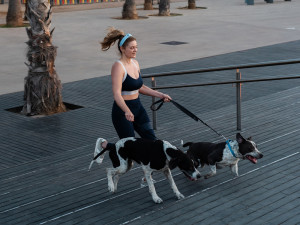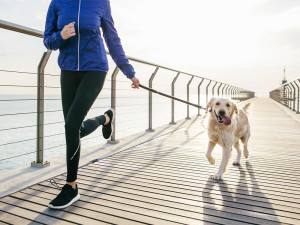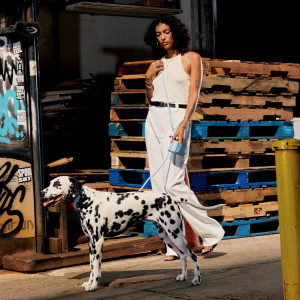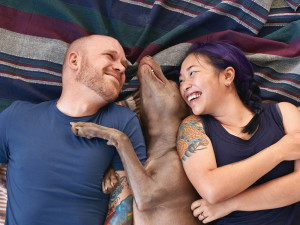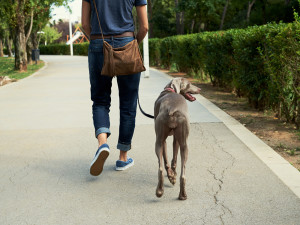Dogs Make Great Exercise Partners
Helpful tips on shaping up with your dog.

share article

Your pet wants you to read our newsletter. (Then give them a treat.)
Making positive, healthy changes in your life isn’t always easy, but your dog can help. Less than 25% of people who start an exercise routine stick with it for more than a month. But pet parents who report walking their dogs are almost 25 percent less likely to be obese than people without dogs. It’s a little tougher to skip your jog if your pup is waiting for you by the door.
Dogs help you get moving.
Frank Wisneski of West Covina, Calif., started smoking when he was 11 years old. When hit by a heart attack at the age of 38, he weighed 215 pounds and had been smoking a pack a day for 27 years. “At the rate I was going, I realized I probably wasn’t going to be around to help my wife take care of our daughter. That’s what pushed me to quit smoking. About six months after that, we got our dog, and I’ve been running with him ever since.”
Major, his black Lab, is Wisneski’s primary exercise partner. The pair runs four to five miles every weekday morning, starting out at 4 am, before Wisneski goes to work. On weekends, he and Major hit the trails around a local lake, where the dirt is a bit easier on the joints, running up to 16 miles in a day.
Wisneski, who now weighs 180 pounds and has completed five marathons, gives his dogs full credit for his good health. “Dogs don’t care if it’s raining. Dogs don’t care if it’s cold. Dogs don’t have another meeting to be at or some other obligation. Dogs are the best training partners ever. They just want to spend time with you. If you’ve got to get up and go run, you’ve always got a partner to go with you.”
Walking benefits you and your dog.
Dogs make wonderful walking and exercise buddies. If you look at your dog as a workout partner, they can provide you with motivation to be both happier and healthier. Phil Zeltzman, DVM, a certified vet surgeon based in Pennsylvania and author of Walk a Hound, Lose a Pound, completely agrees. “People make up all kinds of excuses not to exercise, but dogs are always ready to go,” he says. Multiple scientific studies have shown that humans and dogs derive similar physical, psychological and emotional benefits from exercise. Zeltzman recommends that dogs of all ages have a complete physical exam before beginning any exercise program.
Tips on Exercising with Your Pup:
Tailor your activity to your dog’s breed, age, personality and health status. Start slow and progressively build endurance. If you and your dog are just starting to exercise, begin with simple walks, which can later morph into more strenuous activities. Read your dog for stress signals during and after exercise, particularly if your dog is a senior. However, age by itself isn’t a disqualifier, Zeltzman says. “Age is not a disease. I see 12-year-olds that act like six-year-olds.”
At the human end of the leash, the Centers for Disease Control and Prevention (CDC) recommends that adults—including those 65 and older who “are generally fit, and have no limiting health conditions”—get 150 minutes per week of moderateintensity exercise, such as brisk walking. These 150 minutes can be broken into 10-minute increments throughout the day. So, taking a break for a quick stroll with the dog is possible for even the busiest among us.
Does walking your dog count as exercise?
Yep, walking your dog is a great starting point for exercise. “You don’t have to run for hours with your dog to benefit,” Zeltzman says. According to the American Council on Exercise, even modest exercise improves circulation, bringing more oxygen to the heart and muscles and decreasing both the risk and severity of many diseases. Like dogs, people need to start slowly and build up the intensity and duration of their walks. Zeltzman suggests that adding variety to an exercise routine will help ward off boredom; switching up the routine can also help avoid a workout plateau. Following are a few of Zeltzman’s walking suggestions for doing just that.
Here are a few dog walking exercises.
Stair walking.
For a terrific workout that benefits both the cardio system and leg muscles, find a stairwell, either outdoors or indoors. A variety of types of stairs (such as spiral or half-turn stairs) and/or a variety of stair surfaces (wooden, concrete, brick) can add a distraction for the dog that will ultimately build overall confidence. This comes with a caveat, however: many dogs don’t care for open stairs, and they should not be attempted until your dog is a well-seasoned stair climber.
Hiking.
Find a traiopens in a new tabl at a local park and hit the dirt surface. According to Zeltzman, every organ in our bodies benefits from this type of exercise. Add a few obstacles, such as crossing logs and climbing hills, and you’ve engaged even more muscles, built intensity, and spiced up the adventure.
Resistance walks.
Lakes and beaches are prime territory for this activity, which involves walking in shallow water and/or on dry or wet sand. Dry sand is the more strenuous option; walking in it exhausts muscles pretty quickly.
Power walks.
If you are physically fit, power walking provides a thorough workout for both you and your dog. The brisk pace interspersed with intervals of jogging or runningopens in a new tab and/or arm pumping doesn’t allow time to stop and sniff. You can also mix it up with squats, fetch or another activity you both enjoy.
Fetch.
Retrieving can be a great boredom-buster while walking or hiking. However, this doesn’t mean that you get to relax on a stump while your dog fetchesopens in a new tab the ball or toy. Rather, you’ll be moving quickly, either toward or away from the dog, during retrieves. A Frisbee or a portable ball launcher such as a Chuckit complements exercise routines.
Other ways to exercise with your dog without walking.
There are many creative ways to get active with your dog, such as dog yogaopens in a new tab, dog agilityopens in a new tab, and couch to 5K programs, but start slowly as with any new program. Just as someone shouldn’t run a full marathon without training, the same holds true for dogs. It’s essential to work them up slowly, especially if your dog hasn’t been highly active.
Another option is swimming. Taking your dog for a swim is easy on the joints and great for building endurance. Introduce your pup to water slowly, perhaps starting with resistance walks in warm, shallow water. Add a floatable ball and retrieves can be enjoyed by all.
Making an exercise plan:
“When starting a diet and exercise plan with your dog, just remember P.A.W.S.,” says Dr. Arielle Markley, a veterinarian in the Canine Physical Rehabilitation & Sports Medicine Center at The Ohio State University Veterinary Medical Center. PAWS stands for:
Plan
Schedule your workouts, make grocery lists, and plan out the daily practices that are going to help you reach your goals. Over time, you’ll see significant results if you make small manageable changes.
Active
Get active with your dog in ways that you both enjoy, whether that’s running, playing, or even doing doggie yoga.
Wellness
Checkups are crucial for both you and your dog. Get a regular checkup to ensure you are healthy enough for exercise and determine your specific dietary needs. When you call your vet to schedule your dog’s annual checkup, give your primary care physician a call as well.
Success
Don’t forget to celebrate and reward your success but try swapping out treats and junk food for some extra love and attention for your dog.
“Dogs are the best for a healthy, active lifestyle. If a dog is by your side, they don’t care what they are doing. And if they get to smell a park along the way, that’s a good day,” says Wisneski, who credits his canine exercise partners with saving his life every day.
Before getting started on any rigorous diet or exercise program, talk to your doctor and veterinarian. It’s important to make sure that there aren’t any other health conditions that might keep either of you from your goals and have a tailored plan to your individual needs.
Cynthia Howle
Cynthia Howle is a freelance writer living in Oxford, Mississippi. Her work has appeared in The New York Times, Dogster, AKC's Family Dog, The Bark, and Dogs Naturally (Canada).
Related articles
![A dog running with a woman on a pier.]() opens in a new tab
opens in a new tab8 Questions to Ask Yourself When Choosing a Dog Breed
Find out which dog breed is right for your lifestyle.
![A stylish young woman wearing a white jumpsuit walking her Dalmatian dog with a light blue hands-free leash made by the Fable brand]() opens in a new tab
opens in a new tab8 Hands-Free Dog Leashes for Running (or Texting)
Remember to stay alert!
![Happy pet owners cuddling with their dog]() opens in a new tab
opens in a new tab10 Ways to Spark Joy in Your Dog’s Life
(And your own, while you’re at it.)
![Woman in athletic clothing jogging up stairs in a tropical city with her two dogs on leashes running with her]() opens in a new tab
opens in a new tabRunning With Your Dog Is Possible — It Doesn’t Just Happen in Photoshoots
You — yes you! — can be one of those fun people who runs with your dog. Just be smart about it.
![A person walking a dog on a paved road in a park.]() opens in a new tab
opens in a new tab4 Ground Rules for Good Dog Walking Etiquette
Your neighbors will thank you.

